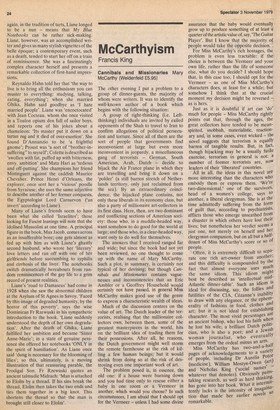McCarthyism
Francis King
Cannibals and Missionaries Mary McCarthy (Weidenfeld £5.95) The other evening I put a problem to a group of dinner-guests, the majority of whom were writers. It was to identify the well-known author of a book which begins with the following situation: A group of right-thinking (i.e. Leftthinking) individuals are invited by exiled opponents of the Shah to travel to Iran to confirm allegations of political persecution and torture. Since all of them are the sort of people that governments find inconvenient at large but even more inconvenient in jeopardy, a miscellaneous gang of terrorists — German, South American, Arab, Dutch — decide to hijack the Air France plane in which they are travelling and bring it down on a 'polder' (a still barren stretch of Netherlands territory, only just reclaimed from the sea). By an extraordinary coincidence, the hijacked plane contains, not only these liberals in its economy class, but also a party of millionaire art-collectors in its first class. Here, then, are two dominant and conflicting sections of American society: those who, in a muddle-headed way, want somehow to do good for the world at large; and those who, in a clear-headed way, want only to do well for themselves.
The answers that I received ranged far and wide; but since the book had not yet been reviewed, no one thought to come up with the name of Mary McCarthy. Such a plot, in summary, is certainly not typical of her devising; but though Cannibals and Missionaries contains vaguenesses and inconsistencies that an Eric Ambler or a Geoffrey Household would certainly not have passed, in general Miss McCarthy makes good use of the genre to express a characteristic wealth of ideas.
Much of the discussion centres on the value of art. The Dutch leader of the terrorists, realising that the millionaire collectors own, between them, some of the greatest masterpieces in the world, hits on the brilliant idea of trading them for their possessions. After all, he reasons, the Dutch government might well storm the remote farmhouse at the risk of killing a few human beings; but it would shrink from doing so at the risk of destroying even one important work of art.
The problem posed is, in essence, the old one: if a house were burning down and you had time only to rescue either a baby in one room or a Vermeer in another, which would you choose? In such circumstances, I am afraid that I should opt for the Vermeer — unless I had some divine assurance that the baby would eventually grow up to produce something of at least a quarter of the artistic value of, say, 'The Guitar Player'. But I know that the majority of people would take the opposite decision.
For Miss McCarthy's rich hostages, the problem is even less tractable: if the choice is between the Vermeer and your own life, rather than the life of someone else, what do you decide? I should hope that, in this case too, I should opt for the Vermeer — as one of Miss McCarthy's characters does, at least for a while; but somehow I think that at the crucial moment my decision might be reversed — as is hers.
Just as it is doubtful if art can 'do' much for people — Miss McCarthy rightly points out that, through the ages, the great collectors have tended to be meanspirited, snobbish, materialistic, reactionary and,. in. some cases, even wicked — the novel suggests that terrorism is equally barren of tangible results. But, in fact, though hijacking may be a usually futile exercise, terrorism in general is not: a number of former terrorists are, now lekders of their 'liberated' countries. All in all, the ideas in this novel are more interesting than the characters who embody them or express them. 'We're two-dimensional,' one of the survivors, head of a women's college, says to another, a liberal clergyman. She is at the time admittedly suffering from the form of guilt that, according to psychiatrists, afflicts those who emerge unscathed from a disaster in which others have lost their lives; but nonetheless her verdict seems a just one, not merely on herself and her clergyman companion, but on all but a halfdozen of Miss McCarthy's score or so of people. Often, it is extremely difficult to separate one rich art-owner from another, and this difficulty is compounded by the fact that almost everyone uses much the same idiom. This idiom ntlet best be described as 'intellectual mid Atlantic dinner-table'. Such an idiom is ideal for discussing, say, the follies and futilities of the CIA, Cezanne's inability to draw with any elegance, or the' ephemerality of fashions in food, clothes and art; but it is not ideal for establishing character. The most vivid personages are an ancient bishop, who lost his faith when he lost his wife; a brilliant Dutch polIt clan, who is also a poet; and a Jewish woman journalist, who eventually emerges from the ordeal minus an arm. Miss McCarthy has two-and-a-halt pages of acknowledgements to a variety of people, including Dr Aurelia Potor (medicine), William Mostyn-Owen (art) and Nicholas King ('social names, whatever that denotes). Obviously.par taking research, as well as hard thinking: has gone into her book. What it interm. tently lacks is the intensity of imagainao tion that made her earlier novels s remarkable.


































 Previous page
Previous page